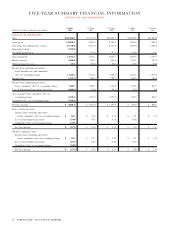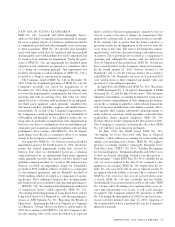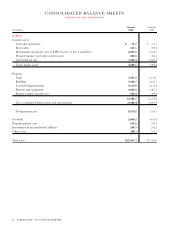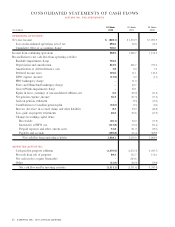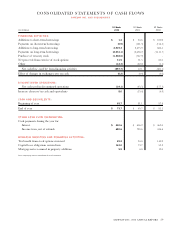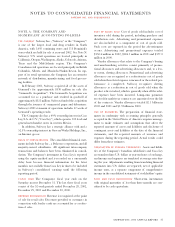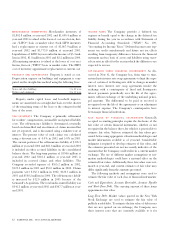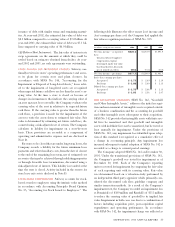Safeway 2002 Annual Report Download - page 26
Download and view the complete annual report
Please find page 26 of the 2002 Safeway annual report below. You can navigate through the pages in the report by either clicking on the pages listed below, or by using the keyword search tool below to find specific information within the annual report.
24 SAFEWAY INC. 2002 ANNUAL REPORT
In January 2003, FIN No. 46, “Consolidation of Variable
Interest Entities,” was issued. This interpretation requires a
company to consolidate variable interest entities (“VIE”) if
the enterprise is a primary beneficiary (holds a majority of
the variable interest) of the VIE and the VIE possess specif-
ic characteristics. It also requires additional disclosure for
parties involved with VIEs. The provisions of this interpre-
tation are effective in 2003. Adoption of this interpretation
will not have a material effect on the Company’s financial
statements.
FORWARD-LOOKING STATEMENTS
This Annual Report contains certain forward-looking state-
ments within the meaning of Section 27A of the Securities Act
of 1933 and Section 21E of the Securities Exchange Act of
1934. Such statements relate to, among other things, capital
expenditures, acquisitions, the valuation of Safeway’s invest-
ments, operating improvements and costs, tax rate and gross
profit improvement, and are indicated by words or phrases such
as “continuing,” “ongoing,” “expects,” and similar words or
phrases. The following are among the principal factors that
could cause actual results to differ materially from the forward-
looking statements: general business and economic conditions
in our operating regions, including the rate of inflation, con-
sumer spending levels, population, employment and job growth
in our markets; pricing pressures and competitive factors, which
could include pricing strategies, store openings and remodels by
our competitors; results of our programs to control or reduce
costs, improve buying practices and control shrink; results of
our programs to increase sales, including private-label sales, and
our promotional programs; results of our programs to improve
capital management; the ability to integrate any companies we
acquire and achieve operating improvements at those compa-
nies; changes in financial performance of or our equity invest-
ments; increases in labor costs and relations with union
bargaining units representing our employees or employees of
third-party operators of our distribution centers; changes in
state or federal legislation or regulation; the cost and stability of
power sources; opportunities, acquisitions or dispositions that
we pursue; the rate of return on our pension assets; and the
availability and terms of financing. Consequently, actual events
and results may vary significantly from those included in or con-
templated or implied by such statements. The Company under-
takes no obligation to update forward-looking statements to
reflect developments or information obtained after the date
hereof and disclaims any obligation to do so.
In December 2002, the FASB issued SFAS No. 148,
“Accounting for Stock-Based Compensation – Transition and
Disclosure.” SFAS No. 148 amends SFAS No. 123,
“Accounting for Stock-Based Compensation,” to provide alter-
native methods of transition for a voluntary change to the fair
value based method of accounting for stock-based employee
compensation. In addition, SFAS No. 148 amends the disclo-
sure requirements of SFAS No. 123 to require prominent
disclosures in both annual and interim financial statements
about the method of accounting for stock-based employee
compensation and the effect of the method used on reported
results. The provisions of SFAS No. 148 are effective for
financial statements for fiscal years ending after December 15,
2002. The Company accounts for stock-based employee com-
pensation arrangements in accordance with the provisions of
Accounting Principles Board Opinion No. 25, “Accounting
for Stock Issued to Employees,” and complies with the disclo-
sure provisions of SFAS No. 123 and SFAS No. 148.
EITF Issue No. 02-16, “Accounting by a Reseller for
Cash Consideration Received from a Vendor,” provides that
cash consideration received from a vendor is presumed to be
a reduction of the prices of the vendor’s products or servic-
es and should, therefore, be characterized as a reduction in cost
of sales unless it is a payment for assets or services delivered to
the vendor, in which case the cash consideration should be
characterized as revenue, or it is a reimbursement of costs
incurred to sell the vendor’s products, in which case the cash
consideration should be characterized as a reduction of that
cost. EITF No. 02-16 becomes effective for the Company in the
first quarter of 2003. The Company is currently analyzing the
effect that adoption of EITF No. 02-16 will have on its
financial statements.
In November 2002, FASB Interpretation (“FIN”) No. 45,
“Guarantor’s Accounting and Disclosure Requirements
for Guarantees, Including Indirect Guarantees and
Indebtedness of Others,” was issued. This interpretation
requires the initial measurement and recognition, on a
prospective basis only, to guarantees issued or modified after
December 31, 2002. Additionally, certain disclosure require-
ments are effective for financial statements ending after
December 15, 2002. The Company complies with the dis-
closure provisions of FIN No. 45 and is currently assessing
the impact that adoption of FIN No. 45 will have on the
Company’s financial statements.




